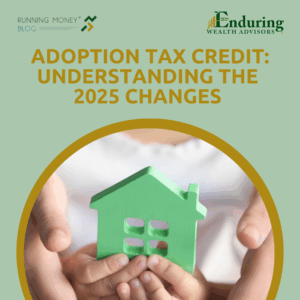 Building a family through adoption brings immeasurable joy alongside significant financial considerations. The One Big Beautiful Bill Act of 2025 (OBBBA) delivered meaningful improvements to the Adoption Tax Credit that can reduce your tax burden and strengthen your family’s financial position during this important transition.
Building a family through adoption brings immeasurable joy alongside significant financial considerations. The One Big Beautiful Bill Act of 2025 (OBBBA) delivered meaningful improvements to the Adoption Tax Credit that can reduce your tax burden and strengthen your family’s financial position during this important transition.
What Changed in 2025: The Bottom Line Up Front
Three key improvements took effect January 1, 2025:
- Partial refundability: $5,000 of the credit is now refundable, meaning you can receive this portion as a cash refund even if you owe no federal taxes.
- Annual adjustments: Both the total credit ($17,280 in 2025) and refundable portion ($5,000) will increase annually with inflation. Verify current amounts when filing, as these figures will likely be higher in future years.
- Tribal recognition: Indian tribal governments can now designate “special needs” children, expanding access for Native American adoptions.
Understanding the Numbers
For 2025, each eligible child adoption qualifies for up to $17,280 in tax benefits:
- Refundable portion: $5,000 (received as cash refund regardless of tax liability)
- Nonrefundable portion: $12,280 (can only offset taxes you actually pay)
The credit cannot exceed your qualified adoption expenses. If you spend $10,000 on adoption costs, your maximum credit is $10,000, not $17,280. The credit phases out between $252,150 and $292,150 of modified adjusted gross income (MAGI), with complete elimination above $292,150.
Maximizing Your Tax Benefits
The key to optimizing your adoption credit depends on your federal tax liability in the adoption year.
If your federal income tax is $17,280 or more: You can use the full credit immediately. The non-refundable portion wipes out $12,280 of your tax bill, plus you receive the $5,000 refundable portion. We don’t yet know whether you’ll get a refund or tax credit carry-forward for any unused credit if your tax is between $12,280 and $17,280, but there may be precedent for using the non-refundable portion first and getting the refundable portion in the same year.
If your federal income tax is less than $12,280: You’ll have to carry-forward any remaining tax credits into future years (up to five years). However, if you’d like to take maximum benefit of the credit now, and have traditional retirement assets which will be taxable when withdrawn, consider doing a Roth conversion.
Example: Sarah and David typically pay $8,000 in federal taxes annually on approximately $70,000 of taxable income. They’ll have about $9,000 of tax credit available, which could be used to cover the income tax on the Roth Conversion which gives them a tax-free bucket of future retirement money. Typically, we’d want to convert enough to reach the ceiling on their currently low tax bracket (about $25,000 in this example), and if that doesn’t consume the full credit, they’ll either get a refund or carry-forward any remaining credits.
Special Needs Adoptions
Families adopting special needs children receive the maximum tax credit regardless of their out-of-pocket expenses.
A child qualifies as special needs when all three conditions are met:
- The child was a U.S. citizen or resident when adoption efforts began, and
- A state or tribal government determined the child cannot return to birth parents, and
- Authorities determined the child is unlikely to be adopted without assistance
Foster-to-adopt: Children adopted from foster care often meet the special needs criteria since they’ve typically been removed from their birth parents by state authorities and may be harder to place due to age, sibling groups, or other factors. This suggests that many families who adopt children out of foster care may qualify for the full $17,280 credit. The system has a shortage of loving homes willing to foster and adopt.
Key strategies for special needs adoptions:
Government determination required: “Special needs” for tax purposes require an official state or tribal government determination – you cannot self-designate based on the child’s circumstances alone. The state must formally determine that the child cannot return to birth parents AND that the child won’t be adopted without assistance.
Documentation to keep: Keep a copy of the adoption assistance agreement in your files, as this serves as evidence of the state’s special needs determination. The IRS no longer requires you to attach adoption documentation with your tax return, but you must maintain these records in case of audit.
Coordinate with other benefits: State adoption assistance programs and other support services don’t affect your federal tax credit eligibility.
Coordinating with Employer Benefits
Some large companies offer meaningful amounts of adoption assistance programs that can be used in addition to the tax credits to cover your expenses. You cannot claim both the employer exclusion and tax credit for the same expenses, so coordinate strategically—employer programs typically handle direct payments to agencies more easily, while the tax credit works well for out-of-pocket expenses like travel costs. Additionally, roughly one-third of employers now offer paid adoption leave, which represents significant value even if separate from the tax credit. If your employer offers adoption benefits, review the program details early in your adoption process to maximize your combined tax advantages.
Timing Matters: When to Claim the Credit
Domestic adoptions (including unsuccessful attempts): You can claim credits for expenses as you pay them, even before finalization. If expenses are paid before finalization, claim the credit the year after payment. If expenses are paid during or after finalization, claim the credit the year paid.
Foreign adoptions and special needs domestic adoptions: All expenses must be claimed in the year the adoption becomes final, regardless of when expenses were actually paid.
Employer benefits timing: For foreign adoptions, any employer benefits received before finalization must be included in your income initially, then excluded through an adjustment in the year the adoption becomes final.
Documentation Requirements
Maintain comprehensive records for IRS Form 8839:
- Child’s name, age, and taxpayer identification number
- Detailed records of all qualified expenses with receipts
- Special needs designation documentation (when applicable)
- Employer adoption assistance statements
Adoption fees, attorney costs, court fees, travel expenses (meals and lodging), and re-adoption costs for foreign children generally qualify. However, expenses violating federal/state law, reimbursed amounts, government-funded expenses, surrogate arrangements, and stepchild adoptions do not qualify for the tax credit.
Planning Beyond the Credit
As with any change in the size of your family, it’s a good idea to review your financial situation. Your Certified Financial Planner® should be able to help you adjust to your new situation, including education funding, cash flow analysis, risk (insurance) review, and any beneficiary updates needed.
Looking Forward
The enhanced Adoption Tax Credit provides meaningful financial support for families building through adoption. Families beginning adoption journeys should factor these benefits into their financial planning, while those currently in process should evaluate whether timing adjustments could optimize their tax benefits.
If you’re considering adoption or currently navigating the process, we can help you develop a comprehensive strategy that aims to maximize available tax benefits while positioning your family for long-term financial success. The emotional rewards of adoption are immeasurable—but the financial aspects deserve thoughtful planning to support your growing family’s future.
Research and development of this article included the use of artificial intelligence tools.
A Roth IRA conversion—sometimes called a backdoor Roth strategy—is a way to contribute to a Roth IRA when income exceeds standard limits. The converted amount is treated as taxable income and may affect your tax bracket. Federal, state, and local taxes may apply. If you’re required to take a minimum distribution in the year of conversion, it must be completed before converting.
To qualify for tax-free withdrawals, you must generally be age 59½ and hold the converted funds in the Roth IRA for at least five years. Each conversion has its own five-year period, and early withdrawals may be subject to a 10% penalty unless an exception applies. Income limits still apply for future direct Roth IRA contributions.
This material is for informational purposes only and does not constitute tax, legal, or investment advice. Please consult a qualified tax professional regarding your individual circumstances.
A Roth IRA offers tax deferral on any earnings in the account. Qualified withdrawals of earnings from the account are tax-free. Withdrawals of earnings prior to age 59 ½ or prior to the account being opened for 5 years, whichever is later, may result in a 10% IRS penalty tax. Limitations and restrictions may apply.
